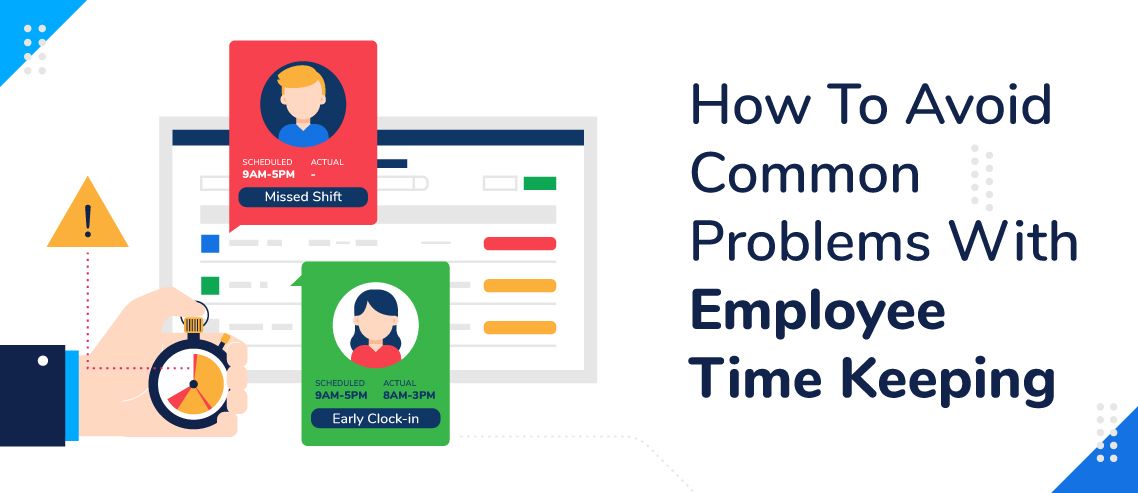How To Avoid Common Problems With Employee Time Keeping

Are your employees stealing time?
There are a few ways they can do this. First, they can outright falsify time sheets. Second, your employees can waste enormous amounts of time while at work.
When it comes to paying your employees for their time, it doesn’t really matter how they’re stealing it or wasting it, just that they are.
Employers have an obligation to their bottom line to monitor the hours their employees are working. If you don’t, you risk budget overages.
In this article, we look at ways to monitor and fine tune your time tracking. Here’s how to avoid common problems with employee time keeping.
First, let’s look the ways time theft can occur.
Ways Employees Steal Your Company’s Time
What is time theft? It’s when your employees cash a paycheck that includes hours they didn’t actually work.
It’s widely accepted that one-third of your employees have stolen time at one time or another. And, just one of your employees who steals or wastes just 15 minutes each day costs you a week’s pay each year.
Add that up for each of your employees, and the number is staggering.
For companies still using paper time sheets, detecting time theft is often difficult. Employees who log their own hours on a time sheet often round up or don’t take off the time they spend gabbing with co-workers.
The most common type of time theft comes during break times. For example, you offer one 15-minute break per day, but your employee takes two. Or, your employee spends 10 minutes each day gossiping with the co-worker in the next cubicle.
Another common type of type theft comes when your employees text, take phone calls, surf the web or use social media. They are using your time for their personal business.
Now, here’s how to avoid common problems with employee time keeping.
Avoid Time Theft with Communication
It seems like you should be able to trust your employees, right? It also seems like your employees would know that their time costs you money. Often times neither of these scenarios is true.
When it comes to avoiding time theft, one way is with communication. Perhaps that employee who gossips each morning for 10 minutes doesn’t realize she’s costing you money.
You want to let your employees know through your employee manual, onboarding and ongoing training what your expectations are.
Lay out a plan for personal time that includes phone calls, text and Internet usage. Acknowledge that time spent chatting with fellow employees can be good for team building (in moderation), but let your employees know when it’s acceptable and when it’s not.
When it comes to communication, you want to be very specific about what’s allowable. Be sure to let your employees know the repercussions if they don’t comply.
Avoid Time Theft with Accountability
Another way to encourage proper time keeping is with employee incentive or reward programs.
Create time-based goals for your employees. Monitor their progress and reward accurate, on-time work.
This creates accountability on their part that they know has consequences.
This can go a long way toward preventing time theft.
Avoid Time Theft by Leading
Do you waste time at work?
Ensure that you’re being a good steward of your time. Keep personal calls to a minimum and avoid extended breaks.
Set the example for your employees. This helps your employees know what’s expected. If they constantly see you shirking your duties, they’ll feel like it’s okay for them.

Avoid Time Theft with Software
ZoomShift is time tracking software that can help your company prevent time theft.
Our time clock software not only tracks employee time, but with it, you can compare scheduled time to actual worked time and export it to your payroll system.
You’ll instantly know which of your employees are milking the clock and stealing time. With ZoomShift, you’ll also know who isn’t working a full shift.
This is all done electronically, so you don’t have to waste your own time comparing scheduled shifts against actual hours worked.
ZoomShift works with your employees. They can download the app to their computer, tablet or phone, so they have their own time clock right in their pocket.
Plus, the ZoomShift time clock sees the schedule. It knows if an employee is clocking in when they’re supposed to and warms employees if they clock in and aren’t scheduled.
What’s more, with ZoomShift, you can whitelist IP addresses. This lets you know if employees are clocking in at the location they’re working. This keeps employees from clocking in on the bus while they’re’ running late for work.
Using time keeping software like ZoomShift takes the guesswork out of employee time theft. It eliminates the hassles and lets you and your employees focus on getting the work done.
Final Thoughts
Most businesses can expect some time theft to occur. But, there are ways to avoid it and even stop it altogether.
Time theft affects your company’s productivity and your profitability. While some employees do it on purpose, others may not even know they’re doing it. The bottom line is that it affects you either way.
Stealing time is just as bad as stealing a product. Follow our tips listed here to keep your employees from stealing time.
An employee management tool like ZoomShift helps you manage your employee time keeping. It can assist your company by getting rid of budget overages and time theft problems.
Bottom line – use a time keeping system to help you prevent time theft and increase employee productivity.
**Are you ready to leverage the power of ZoomShift? Smart business owners are freeing up their time by using employee scheduling and timeclock software. Contact us today to start your free trial and get started.**
JD enjoys teaching people how to use ZoomShift to save time spent on scheduling. He’s curious, likes learning new things everyday and playing the guitar (although it’s a work in progress).



